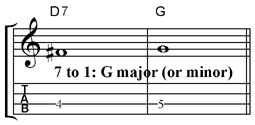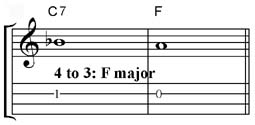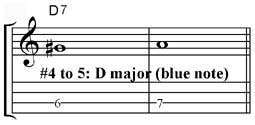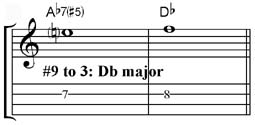« How to make your playing swing! |
Main
| Thin-slicing and Music Theory »
 December 1, 2011 | Top Five 'Hover' Tones December 1, 2011 | Top Five 'Hover' Tones
Enjoy the popular archive material below.
From May 13, 2010: "Top Five 'Hover' Tones"
We revisited the notion of "gravity" in melody a couple weeks ago. We mentioned in particular, the pull of the 4th and 7th scale degrees, but we thought we'd expand these and call out our Top Five "Hover" tones.
Think of the drama of a Life-flight helicopter attempting to make a landing at a hospital, right before they are able to clear the emergency pad. There is tension literally in the air, as pilot, staff, observing public, and no doubt the patient as they wait to land. Maybe the drama of a scale degree is nothing compared to this, but you get the idea. Some notes "hover" as they wait to fulfill their mission, to land on the note that brings a sense of completion. We give you our personal Top Five:
 7 to 1 Major & Minor Scale. 7 to 1 Major & Minor Scale.
This is really a no-brainer, and the single most recognizable melodic pull in the tonal universe. Run the first seven notes in a G major scale and stop on the F#, just short of completion. Gaze around and see how many in the room look at you in anticipation. Many might even participate and sing the note G out for you, just to stop the demons from coming. Notice this is the same in both major and minor scales. That half-step relationship offers a very strong vertical bond.
 4 to 3 Major Scale. 4 to 3 Major Scale.
While not quite as strong as the previous 7 to 1, this is a potent one, too. Partnered up with the 7 to 1, you get the Tritone harmonic pull, the 4th & 7th to the 3rd and 1st. Even by itself, in the major scale its half-step tug demands its destiny, that "welcome home" 3rd scale degree.
 6 to 5 Minor Scale (AKA b9). 6 to 5 Minor Scale (AKA b9).
We have to give equal time to the minor scale and mention the 6th degree, where again we have a half-step pull to the 5th. We've mentioned its role as the b9 of the V7 chord (V7b9) above, but we could also point to the dominant preparation chord, the ii7b5 or Bm7b5, "F" in the above example. Eventually, it longs for the 5th note of the minor scale.
 #4 to 5 Blues Scale. #4 to 5 Blues Scale.
This may be cheating a little, because it's not really a major or minor scale tone, unless you're talking a Blues Scale. We mention it because it's a very popular coloring tone, and one of those "blue" notes oozing with character. You can think of it as a b5 scale degree, too. What you call it is your choice, depending on what direction you're going, toward the 5, or teasing with a little half-step dip away from the 5 and back.
 #9 to 3 Major Scale #9 to 3 Major Scale
This might be more esoteric, because we usually think of the #9 (or raised 2) in the context of a chord. It can still pack a punch melodically, and when used in an augmented chord, it needs to its face its fate. Best not to just leave it hanging there.
Why bother?
Voicing is everything in music. Even when you're stringing a succession of chords, these notes should eventually find their nearby mate. Since they are only a fret away, you should maximize your chord effectiveness by hooking chords together that consciously (and conscientiously) match these individual note pairs up. More importantly, if you are soloing, you want to exploit the momentary melodic tension and release here that makes the difference between runny notes, and running notes.
Make 'em count!
Further:
Moving Forward; Melodic Progression
4 and 7. The Committal Notes
Intentional Improvisation
More Appropriate
Some Minor Issues: 'Gravity' Notes in Minor
Posted by Ted at December 1, 2011 5:58 AM

Disclaimer: In the 'Information Age' of the 21st Century,
any fool with a computer, a modem, and an idea can
become a self-professed 'expert." This site does not
come equipped with 'discernment.'
|



